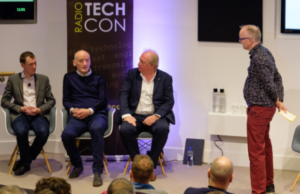
The rise of smart speakers, 5G and AoIP: what we learned at Radio Tech Con 2017
Our round-up of the second independent Radio TechCon, the technology forum for the UK radio industry
Radio TechCon took place at the end of November 2017 with a varied programme of technical sessions covering a range of topics. Held at the London headquarters of the Institute of Engineering and Technology (IET), the conference drew an audience of engineers and technologists from both the BBC and UK commercial sectors, plus representatives of stations in Poland, Germany, Switzerland and Southern Sudan.
The focus of Radio TechCon is largely on current or emerging developments but this time started in the early days of broadcast radio engineering. Angela Stevenson, a senior radio technologist at the BBC, looked at the work of CS Franklin, HJ Round and WT Ditcham, who made significant advances in microphones, amplification and reverberation but are little known today.
A possible future was discussed in the session 5G or not 5G. Andrew Murphy of BBC R&D outlined the three main areas: enhanced mobile broadband, massive machine-type communications and ultra-reliable/low latency comms. He commented that much depends on standardisation, the responsibility of ETSI (European Standards Institute). The proposed standard – 3GPP – comprises Release 15 of 5G plus 4G and the flexible radio interface. An ‘early drop’ of this was due at the end of 2017, with similarly early Phase 1 deployment to come in 2018 followed by a full introduction in 2019. In radio broadcast there is potential for content creation, including metadata. “This could be significant for broadcasting live events,” Murphy said, “instead of using satellite or ADSL.”
The broadcast and multicast aspects of 5G come under the 5G-Xcast project, based on 5GPPP Phase II technology. Mark Henry, head of 5G at BT/EE, observed that the accelerated implementation of 5G was driven by upcoming big events such as this year’s Winter Olympics in South Korea and the 2020 Summer Games in Japan. Henry explained that new radio services would work on a co-existence basis with the ability to scale the amount of frequency involved, although each block still required a certain amount of power for mission critical applications.
Simon Fell, director of technology and innovation at the EBU, commented that 2018 would see 5G projects at the European Championships and trials by NRK in remote areas of Norway. He did, however, warn that bringing about a shift in radio listening might prove difficult because so many conventional radios were already in use.
Another technology that, like 5G, is likely to bring broadcast radio even closer to consumer technology is the smart speaker.
As voice activated devices becomes more mainstream, said Dan McQuillin, managing director of Broadcast Bionics, there was an opportunity for radio stations and software developers to expand what could be done with this new interface.
According to a survey of users of the Amazon Echo, 77% use it for listening to the radio. McQuillin said this would also apply to the other leading smart speaker AIs – Google Home, Apple Siri and Microsoft Cortana – particularly in the important car market.
“It will be omnipotent there, all cars will have them,” he predicted.
To tailor these devices for radio listening, RadioPlayer has developed a new VUX (Voice User Experience) application. Managing director Michael Hill explained that RadioPlayer was approached by Amazon three months before Echo was launched, leading the company to consider the best way to apply voice control to radio. “We started simple, following the adage ‘crawl, walk, run’,” he said. “We then decided to do three things and do them well.”
Audio over IP (AoIP) continues to make inroads into radio, although a straw poll by Jamie Laundon, senior technologist with BBC Design and Engineering, showed that only a small proportion of those in the audience were using network audio.
The title of Laudon’s session, Learning to Play Nicely Together, illustrated that getting devices using different AoIP protocols – Dante, RAVENNA, LiveWire+, Wheatnet and Q-LAN – to work together was still not straightforward.
The situation has improved, he said, since the introduction of the AES67 interoperability standard, which he described as the “O-negative” of audio networking. On top of this, Laudon added, there was now AES70, which specified not only how networks were controlled but also made different set-ups talk to each other.
Radio TechCon is due to return in November 2018, although a definite date and venue have not been confirmed.
Source: mi-pro.co.uk













